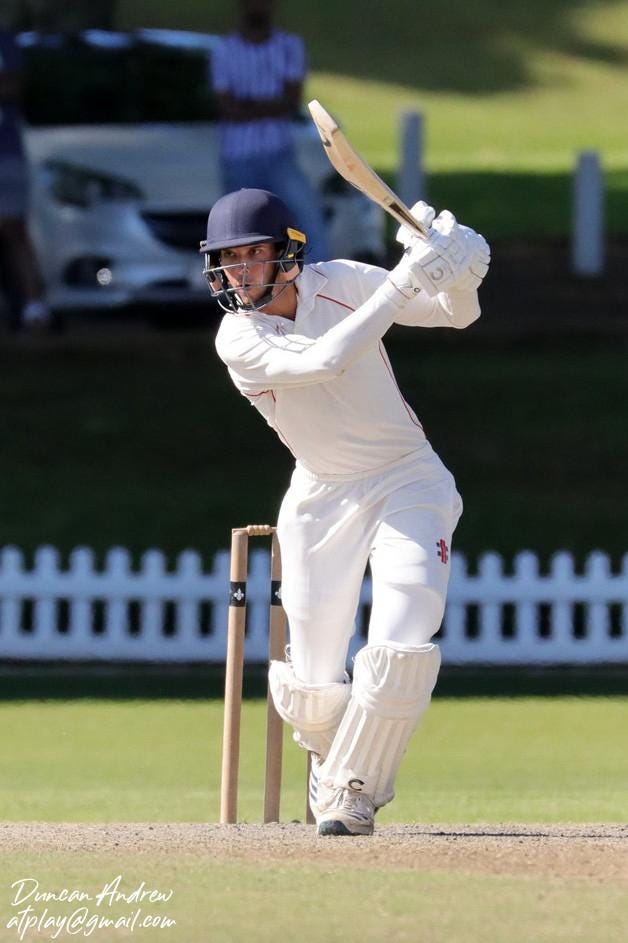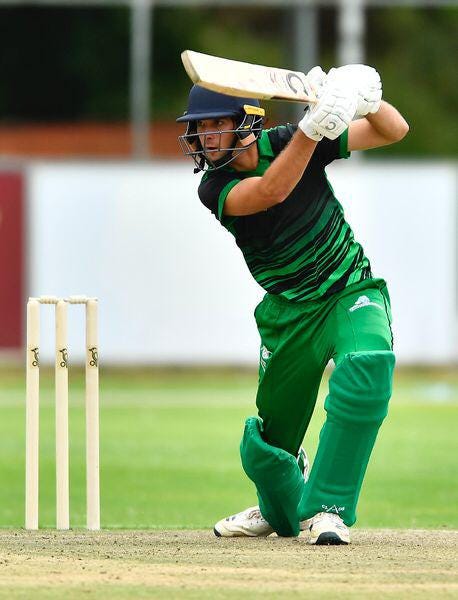There are players like Tristan Stubbs, Dewald Brevis, Lhuan-dre Pretorius, and Kwena Maphaka. They make their senior debuts early and make an immediate impact. Other players, like 22-year-old Adrien Fisher, take a little longer to find their feet and travel a slightly more scenic route.
While those that have made strides are at the IPL, County Cricket or representing South Africa's Emerging and A sides, Fisher and a few others are polishing their craft at Johannesburg's winter league, the Jozi Cup.
Adrien Fisher knew the moment his bat made contact with the ball that the shot was good. The distinct crack that followed, one that could only be made by the sweet spot, only served to confirm what he knew. The stroke would have run to the boundary on a field, but instead it was smothered by the nets. As nice as that was, Fischer couldn't be more disinterested. He was more worried about his front foot.
He looked down. Part of his foot was on the line. The line isn’t a strip drawn by hand, instead, it is where the matting surfaces meet. Most of the surface is green, and then the section at the batter’s end is grey. Fisher sets up deep in the crease, and the mats meet about 40cm from his front foot when he takes guard.
Fisher spent five years in KZN. He attended high school at Michaelhouse. He developed a longer stride to adapt to the slower pitches in the coastal province. When he returned to Gauteng, he found that his step forward often got him into trouble. The long step meant that his weight transfer wasn’t on point; it left him off balance.
“I figured out that when I was moving too big, my body was leading with my feet instead of me leading with my head and shoulders. I should be moving my head or my shoulder first, and then my feet will follow,” Fisher explained.
Initially, Fisher understood the concept when his coach, Bongani Ntini, explained it to him. However, he didn’t understand why the coach wouldn’t stop pushing him to master it. The light bulb went on when he saw Joshua van Heerden batting in the nets at Irene Cricket Club.
“Coach Bongs calls it mid-crease. You move your feet, but not as much as you're normally doing. It's just transferring your weight and. I just saw how Josh does it, how he stays mid-crease. He doesn't move too big, he just shifts his weight forward and backwards, and it's unbelievable, he'll hit balls for four that we'll probably be leaving or look to defend,” Fisher said.


Some players are one in a million. Sydney Barnes was one of a kind. The English bowler finished his international career with 189 wickets in 27 Tests at an impossible average of 16.43. He would have played more and tormented more bowlers if not for his constant wars with authorities.
It wasn’t often that he came across a batter who tormented him back. However, during the 1913-14 season, he ran into a 24-year-old Herbie Taylor. The batter looked impervious to Barnes’ magic with the ball and often farmed the strike to protect the rest of the South African batting line-up from Barnes. Taylor was so good that he finished the series with 508 runs in 10 innings at an average of 50.8.
His average looks even greater if you consider that South Africa didn’t have good batters during that period. Taylor often had to do the bulk of the work with the bat alone. One can only imagine that he did the same for Michaelhouse during his school years. He was Michaelhouse’s first international cricketer.
He paved the way for Alan Melville, Ossie Dawson, Tufty Mann, Christopher Burger, Kim Elgie, Kelly Seymour, Derek Varnals, and Dale Benkenstein. None of them played to Taylor’s level, who is the best player the institute has produced. Sadly, Michaelhouse has not had an international cricketer since Benkenstein, who played his last ODI in 2002.
Michaelhouse is neither a hotbed for cricket stars nor a collector of young talent. It wasn’t an easy sell to Jacques, who saw his son’s potential in the sport and would have preferred that he go to an institute with a better recent record.
Pretoria Boys High and Affies have brilliant records in churning out professional cricketers. Cornwall Hill College has outstanding facilities. Adrien didn’t have to travel out of Pretoria to find the best coaches and facilities. Any of those schools would have been happy to have him.
Fischer put bowlers on notice with an unbeaten 62 against Trinityhouse in a Sunday League match when he was seven. The half-ton was a harbinger of more milestones against bowlers in Pretoria and Johannesburg, and his dominance at Trinityhouse. Fischer reached a landmark score at Trinityhouse in all his subsequent visits to the institute.
Fischer wasn’t just good against Trinityhouse at Trinityhouse, he had back-to-back 1000-run seasons at u12 and u13 for Lynnwood. He was the youngest player to go past the mark at u12 and became the first player to do it twice at u13. He took his form to provincial cricket, where he smashed an unbeaten 131 for the Titans against Free State. It was the highest score of the week.
Top schools in Pretoria would have rolled out a red carpet for him, but he chose Michaelhouse. A decision Jacques wasn’t fully on board with. However, the older Fischer eventually relented.
It wasn’t the worst decision Fischer made for his career as a cricketer. The move to the coast forced him to make adjustments in his game that turned him into a more well-rounded player.
“The move from Titans to KZN Inland was a little bit tough. I was a little bit young, 14 and trying to figure out my game, trying to grow as a player, but I had no idea what technical mistakes and flaws I had. And yeah. So, while I scored runs in my first phase at Michaelhouse, it wasn't the way I wanted to play,” Adrien explained.
Adrien’s high school career peaked in his final year at Michaelhouse. His best performance for Michaelhouse was a masterful 170 against Kearsney. It is the second-highest individual score by a Michaelhouse batter in 50-over cricket. 16 more runs and he could have equalled Ryan Cotterell’s tally from 1999.
He picked three of the four awards given to outstanding cricketers at the end of the year: The Henry Fotheringham, Dale Benkenstein, and Craig Sugden trophies for the Batsman of the Year, Cricketer of the Year, and Players’ Player of the Year awards. The only one he didn’t bag was the Ravenor Nicholson Trophy for Bowler of the Year.
His coup de grace was finishing the year as the third-highest run-scorer at the 2022 under-19 Cubs Week in Stellenbosch. He creamed a few half-centuries on his way to an average of 65 in four outings. His effort was key in the Dolphins’ u19 Cubs Week team’s path to the title. It is the second-ever Dolphins side to lift the trophy.
Adrien Fischer’s eyes locked in on the ball as Karan Muggan ran in to bowl his medium pacers. Adrien’s eyes were trained on it as it left Muggan’s hand. They were fixed on the ball when it made contact with his bat, and followed it as it flew back over the bowler’s head.
The weather was as close to perfect for a cricket match as it could be. The sun was shining brightly, and there was barely a breeze. The ball hung in the air for a brief moment, just long enough for the sweeper to pluck it before it cleared the ropes. When he was younger, a dismissal like that would have made him seethe with anger.
Adrien has a scale that goes from zero to 10, with the top number representing extreme happiness or anger, depending on what he is evaluating. When he was younger, a dismissal like that would have left his anger scale teetering between nine and 10. He would be livid with himself for either making a wrong choice or not executing the shot properly.
However, when he fell to Muggan’s bowling, Fischer merely tucked the bat under his arm and walked off the park. His anger scale was at zero, the neutral gear. It’s not that he didn’t care. He doesn’t enjoy being dismissed as much as the next batter, but he was also aware of the reason why he was in the Jozi Cup.
“I had certain checkpoints coming into the tournament. I was not worried about getting out. I know it is also important, but I feel like the Jozi Cup has given me the freedom to check if the stuff I've worked on works,” Fischer shared.
After a year of drills to polish his mid-crease weight shifting, he was now good, not as good as Joshua van Heerden, but close enough. His stride was minimal and on point. He demonstrated that when he scored a masterful 102 for Irene Villagers in the Premier League finals playoffs.
He didn’t need to look down to check his stride after his dismissal by Muggan, but he did so regardless. His foot was within the parameters. In addition to the weight transfer, Fischer was also working on his power-hitting. For a long time, his game had been moulded around gap-finding strokeplay.
Playing expansive shots on slow winter pitches at the Jozi Cup was always going to be a tough ask. The ball doesn’t come onto the bat as much. Muscling medium-pacers over the top is harder in those conditions.
“I've also worked on slog sweeping and running down the track a lot against medium pacers. So, I am trying to play those types of shots. And then if I get out, it's OK. I'm working on it. It's just about testing it against bowlers and testing it in live match scenarios with scoreboard pressure,” he explained.
In his second match, Fisher was caught at cow corner, slog sweeping a spinner. As he did after Muggan dismissed him, he took note of the adjustment he needed to make to get the right elevation and distance. Three days later, he was working on his range hitting at St John’s College, preparing for his next Jozi Cup matches. This is his winter to elevate his game and give himself a chance to sign a long-term contract.






